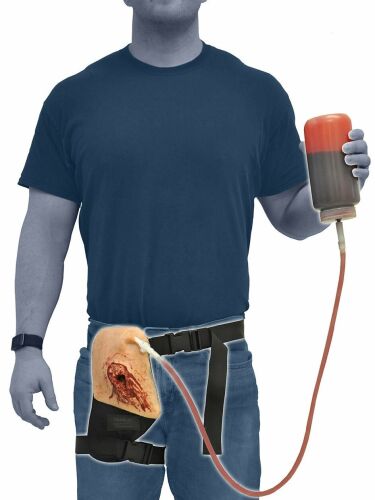Sponsored by Rescue Essentials
By Tim Nowak for EMS1 BrandFocus
Picture this: Your EMS agency switches its traction splints from a ratchet-mechanism device to more of a tent pole-style device. How do you roll out training to everyone on how this new contraption works?
This isn’t the time to pull out a full-size manikin. Instead, you use each other as the “patient” to not only see but also feel how this device operates.
Manikins and stationary training devices certainly have a place in EMS training – like in advanced airway management – but when it comes to other hands-on pieces of equipment, we gravitate toward using each other for the necessary simulation and practice.
This seems to work well for fractures and dislocations, but what about bleeding? How can we use each other to simulate patient care procedures without squirting ketchup on someone’s leg and saying, “Pretend that it’s spurting?”
In instances like that, you’re training about an injury instead of training on an injury.
Super-lifelike manikins can be super expensive, which leaves trainers looking for something a bit more budget-friendly but still realistic. That’s where the emerging line of wearable training devices comes in.
GO HANDS-ON, NOT HANDS-ABOUT
With a wearable training device for bleeding control, your “patient” is lying on the ground with simulated blood actually spurting from a simulated injury – directly on his leg (rather than the table nearby). This requires your crews to act now, and on their “patient.”
Performing the hands-on portion of a skill like wound packing is elevated to a whole new level when the wound is actually on a person, not a table. The difference is that the learner is performing a skill while having to take a live person’s responses (and various levels of cooperation) into account. Blood (even simulated blood) rolls off the skin differently on a human when compared to a mannequin, and the mindset of caring for the entire person sets in when you actually have a person in front of you moving, yelling and acting agitated or in shock.
“You can simulate loss of consciousness or loss of alertness. You also can simulate someone who is belligerent and very resistant to the treatment,” said Brad Day, a research specialist with Luna Innovations, which developed the TrueClot line of training products offered by Rescue Essentials. “There is more realism with the human factor, not just a manikin lying there essentially unconscious.”
TrueClot makes two wearable devices that can be particularly useful for bleeding control training:
SIMULATED, WEARABLE WOUNDS
Here are two scenarios where wearable training tools can be especially useful:
Scenario 1 – Major arm injury that has damaged the brachial artery after an all-terrain vehicle collision
With an arterial bleeding injury simulator, crews can apply a tourniquet to the affected extremity, splint around it and still apply exterior dressings to manage the injury.
A device that mimics actual blood flow that can also be worn on the body is a huge benefit when learning proper tourniquet use. TrueClot created a wearable tourniquet trainer in conjunction with Fairfax Fire and Rescue in Virginia, who specifically wanted a wearable training device that bled. Feedback and requests from agencies in the field are crucial to the product development process, says Day.
“You are not pretending that blood is there,” he said. “The bleeding won’t stop until you’ve applied the tourniquet correctly.”

The TrueClot Inguinal Packing Trainer is a wearable training aid that simulates a junctional hemorrhage that cannot be treated with a tourniquet. Training “blood” is pumped through the device to simulate hemorrhage, and proper wound packing and compression will cause the simulated blood to clot and the hemorrhaging to stop.
Rescue Essentials
Scenario 2 – Bleeding wound to the femoral artery in the upper thigh
Whether from a gunshot, stabbing or other form of puncture, severe bleeds in the inguinal area can’t be treated by a tourniquet. But this is one of the most common areas for wound packing, says Day, and TrueClot developed its wearable inguinal packing trainer in response to customer requests.
“People were using our tabletop wound packing trainer and just holding it in the inguinal space,” Day said, “which would obviously made it difficult to keep securely in place during packing. Plus, you want to feel like you are packing into the actual patient and not six inches above the patient.”
With wearable wound packers like the inguinal trainer, crews can practice packing the wound with hemostatic gauze to control the bleeding, then cover it with a pressure dressing – all while working on an actual human. Having an agitated patient to account for makes these exercises particularly impactful.
GET MORE REALITY FROM YOUR SIMULATED TRAINING
We may not all face these situations in the field on a regular basis. That’s why it’s important to make sure that whatever learning experience we have with them is as realistic as possible.
People say that you should practice how you play. Well, if you’re training to use a device, bandage or other piece of equipment on real people, it only makes sense to make your training as realistic as possible – and that includes using wearable training devices on real people. The goal is to train on a particular device or procedure, not just about it.
For more information on wearable training devices, visit Rescue Essentials.
Read Next: Why you should teach bleeding control for bystanders














